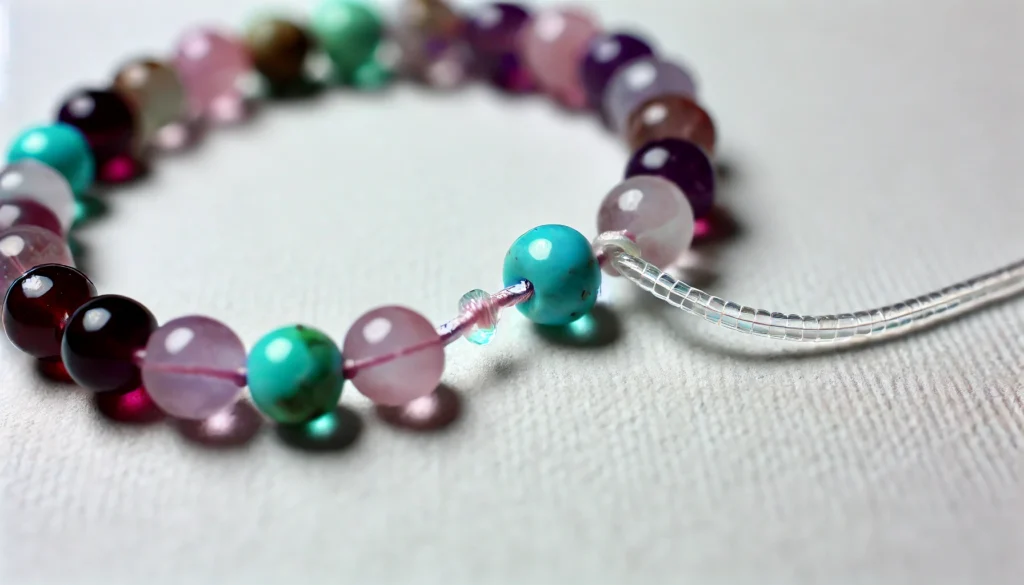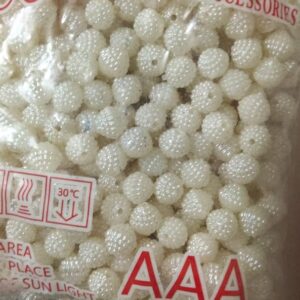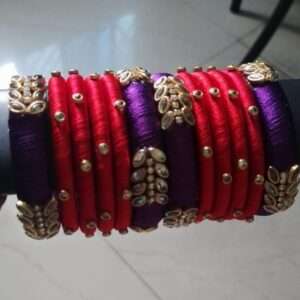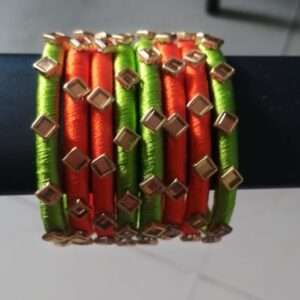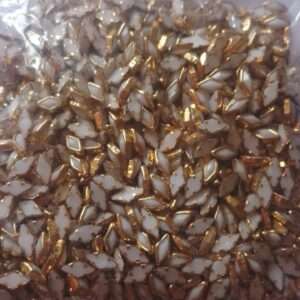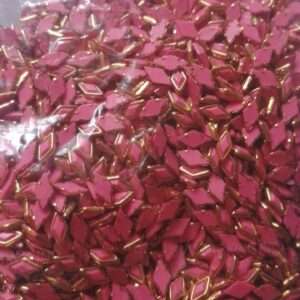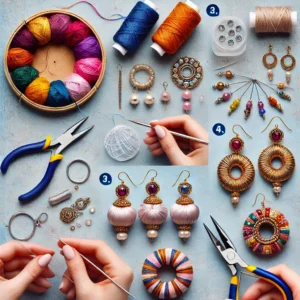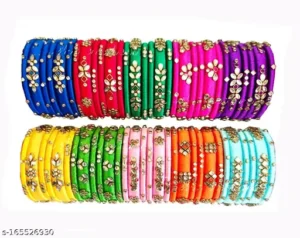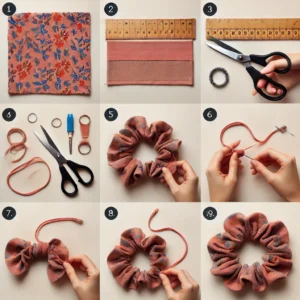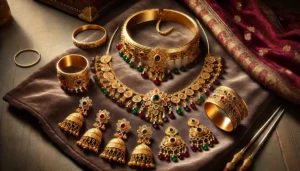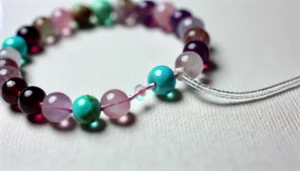Home » My blogs
Category Archives: My blogs
Discover the Rich Significance Behind the Ornaments Worn by Indian Women!
Explore the various traditional ornaments worn by Indian women and their cultural significance. From Maang Tikka to Anklets, discover the beauty and tradition behind each piece.
Indian culture is renowned for its rich tradition of jewelry and ornaments, which are often seen as symbols of beauty, status, and spirituality. Indian women have adorned themselves with various types of jewelry for centuries, each piece carrying cultural, religious, or social significance. The types of ornaments vary across different regions, but they share a common essence of elegance and heritage. This article explores various traditional ornaments worn by Indian women and the significance behind each piece.
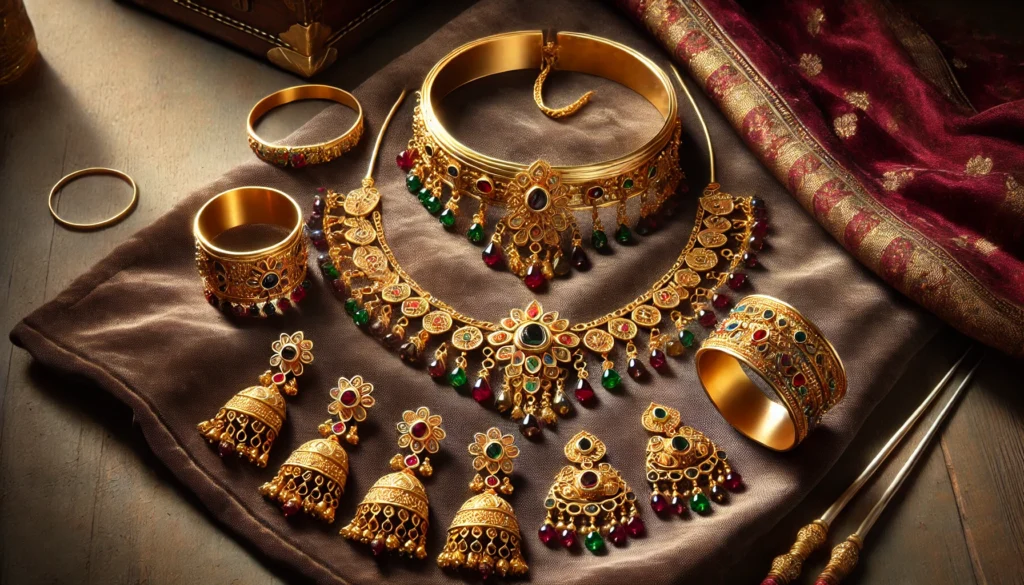
1. Maang Tikka
Description: Maang Tikka is a forehead ornament worn along the parting of the hair, extending to the forehead. It typically consists of a chain with a pendant, and in some cases, a small hook at the back to secure it to the hair.
Significance: Maang Tikka is considered a symbol of feminine power and protection. It is usually worn during weddings and festive occasions. In Hindu tradition, the center of the forehead, where the pendant rests, is believed to be the ajna chakra, or the third eye, representing wisdom and power.
2. Earrings (Jhumkas, Studs, Chandbalis)
Description: Earrings come in various styles, such as Jhumkas (bell-shaped), Studs, and Chandbalis (moon-shaped). They can be made from gold, silver, pearls, or gemstones.
Significance: Earrings are believed to be an important part of a woman’s adornment in India. Jhumkas and Chandbalis are especially popular in South Indian and Mughal-inspired jewelry. They are worn to enhance facial features and are often seen as a mark of traditional beauty.
3. Nose Ring (Nath)
Description: The Nath, or nose ring, is a traditional ornament worn on the nose. It can be a small stud (Phulli) or a large ring (Nath) adorned with pearls or stones, sometimes extending to the ear with a chain.
Significance: The Nath holds immense cultural importance, especially in Indian weddings, where it symbolizes a married woman. It is also considered a mark of beauty and femininity. In Ayurveda, the left nostril is believed to be linked to reproductive organs, and piercing it is said to ease menstrual and childbirth pain.
4. Necklaces (Haar, Mangalsutra, Choker)
Description: Necklaces come in various types, such as the long Haar, the sacred Mangalsutra, and the short Choker. They can be crafted from gold, silver, pearls, or other precious stones.
Significance: Necklaces symbolize prosperity and marital status. The Mangalsutra, a black-beaded necklace worn by married Hindu women, is particularly significant as it represents the husband’s longevity and the sanctity of marriage. Chokers and Haars, on the other hand, are worn for their ornamental and aesthetic value.
5. Bangles (Kangan, Chuda)
Description: Bangles, known as Kangan or Chuda, are worn around the wrists. They are typically made of gold, glass, lac, or other metals and are available in various designs, from simple to heavily embellished.
Significance: Bangles are a symbol of prosperity, marital status, and good fortune. For married women, especially in North India, wearing red and white bangles (Chuda) is considered auspicious. Bangles are also believed to enhance blood circulation due to the constant friction against the wrist.
6. Armlets (Bajubandh)
Description: Armlets or Bajubandhs are worn around the upper arm. They are usually made of gold or silver and adorned with gemstones, pearls, or intricate designs.
Significance: Armlets are worn to symbolize strength and protection. In Indian culture, they are often associated with divine protection and are worn by brides and dancers during special ceremonies and performances.
7. Rings (Anguthi)
Description: Rings, or Anguthis, are worn on the fingers and come in various designs, from simple gold bands to elaborate pieces with gemstones and diamonds.
Significance: Rings are often associated with marital status, especially the engagement and wedding rings. In Indian culture, different fingers have different significances, and rings are believed to enhance particular qualities, such as creativity, love, or prosperity.
8. Waist Belt (Kamarbandh)
Description: Kamarbandh or waist belts are worn around the waist and can be made of gold, silver, or cloth adorned with beads and stones. They often have chains, tassels, or hanging charms.
Significance: Kamarbandhs are worn to accentuate the waistline and add grace to the woman’s gait. Traditionally, they are believed to help maintain posture and balance while walking or dancing. They are a popular accessory during weddings and classical dance performances.
9. Anklets (Payal) and Toe Rings (Bichiya)
Description: Anklets, or Payals, are worn around the ankles, often accompanied by small bells that make a melodious sound. Toe rings, or Bichiyas, are worn on the toes, usually the second toe, and are often made of silver.
Significance: Anklets are considered to attract positive energy and ward off negative influences. Toe rings are traditionally worn by married Hindu women and are believed to enhance reproductive health by applying pressure to specific nerve points.
10. Hair Ornaments (Jadai Billai, Veni, Parandi)
Description: Hair ornaments, such as Jadai Billai (hairpins), Veni (flower decorations), and Parandi (braid tassels), are used to adorn hairdos. They are often crafted from gold, silver, or colorful threads.
Significance: Hair ornaments are a significant part of bridal jewelry in India, symbolizing beauty and femininity. They are also used in classical dance forms to accentuate movements and enhance the overall aesthetic appeal.
Ornaments worn by Indian women are more than just decorative accessories; they carry deep cultural, religious, and social significance. From the Maang Tikka that represents wisdom to the Toe Rings believed to promote health, each piece of jewelry is steeped in tradition and meaning. Indian jewelry not only enhances a woman’s beauty but also connects her to her cultural roots and spiritual beliefs.
DIY Resin Coasters: A Beginner’s Step-by-Step Guide to Creating Stunning Coasters!
Resin art has gained immense popularity in recent years due to its versatility and the unique aesthetic it offers. One of the most popular DIY projects within resin art is creating resin coasters. Resin coasters are not only functional but also add a beautiful touch to home decor. This guide provides a step-by-step process for beginners to create resin coasters, including the materials needed, the process to make them, and where to buy the materials.
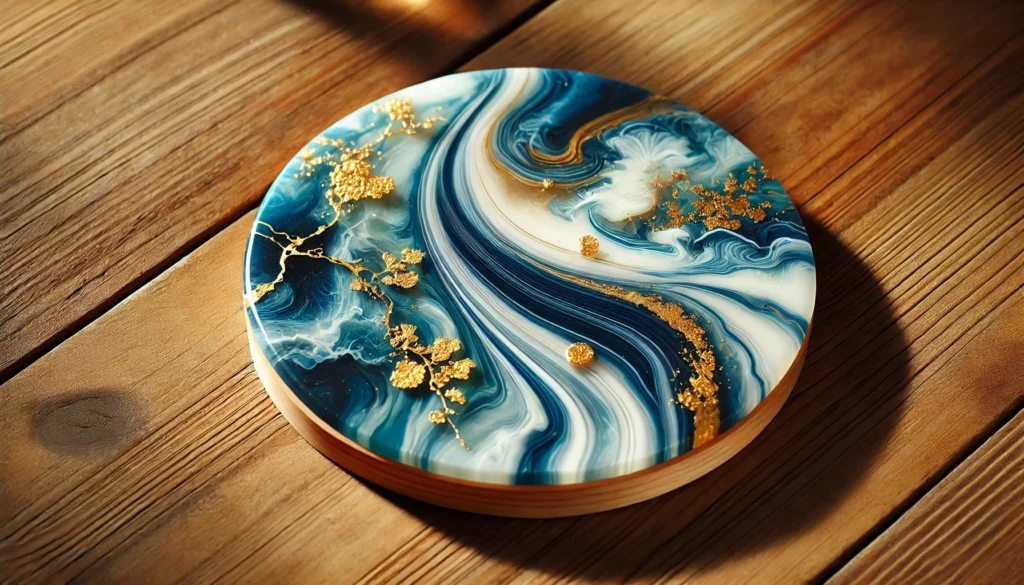
Materials Needed for Making Resin Coasters
Before starting the resin coaster-making process, it is essential to have all the necessary materials on hand. Here is a list of the materials required:
- Epoxy Resin and Hardener: The primary material for resin coasters is epoxy resin, which comes in two parts – resin and hardener. When mixed together, these create a solid, glossy finish.
- Silicone Coaster Molds: These molds help shape the resin into coasters. They come in various shapes like round, square, hexagonal, and more.
- Mixing Cups and Stirring Sticks: Use disposable mixing cups and wooden or plastic stirring sticks to mix the resin and hardener.
- Protective Gear: Gloves, a mask, and safety goggles are essential to protect yourself from the fumes and chemicals while working with resin.
- Heat Gun or Butane Torch: A heat gun or torch is used to remove bubbles from the resin after pouring.
- Pigments and Dyes: To add color to the resin, use mica powders, alcohol inks, or liquid resin dyes.
- Glitters, Dried Flowers, and Other Embellishments: These materials can be used to add decorative elements to the resin coasters.
- Parchment Paper or Plastic Sheet: Place your molds on parchment paper or a plastic sheet to protect your workspace from resin spills.
- Measuring Scale: Accurate measurements of resin and hardener are crucial, so use a digital scale to measure the quantities.
- Resin Release Spray: This spray helps release the resin from the molds easily once cured.
Step-by-Step Process to Make Resin Coasters
Follow these steps to create your own resin coasters:
Step 1: Prepare Your Workspace
Set up your workspace in a well-ventilated area. Cover the surface with parchment paper or a plastic sheet to protect it from resin spills. Make sure all your materials are within reach. Wear protective gloves, a mask, and safety goggles to ensure safety.
Step 2: Measure and Mix the Resin
Carefully measure equal parts of resin and hardener using a measuring scale, following the manufacturer’s instructions. Pour them into a mixing cup and stir slowly for 3-5 minutes using a stirring stick. Make sure to scrape the sides and bottom of the cup to mix thoroughly. Mixing too fast can create bubbles, so take your time.
Step 3: Add Pigments and Embellishments
Divide the mixed resin into smaller cups if you plan to use different colors. Add pigments, dyes, or mica powders to the resin and stir until the color is evenly distributed. You can also add glitters, dried flowers, or other embellishments for a more decorative touch.
Step 4: Pour the Resin into the Molds
Pour the colored resin mixture into the silicone coaster molds. Fill the molds about halfway, and then gently add any additional embellishments you want to include, such as dried flowers or gold flakes. Once you’re satisfied with the design, pour another layer of resin to fill the mold completely.
Step 5: Remove Bubbles
Use a heat gun or butane torch to remove any air bubbles from the resin. Hold the torch or heat gun about 4-6 inches away from the surface and move it around until all the bubbles are gone. Be careful not to overheat the resin, as it can cause it to burn or warp.
Step 6: Let the Resin Cure
Allow the resin to cure according to the manufacturer’s instructions. This process usually takes 24-48 hours. Make sure the molds are placed on a level surface and cover them with a box or a lid to protect them from dust and debris.
Step 7: Demold the Coasters
Once the resin has fully cured, gently remove the coasters from the silicone molds. If you used a resin release spray, this process should be easy. If not, carefully peel the mold away from the coaster to avoid damaging it.
Step 8: Sand and Finish the Edges
If the edges of the coasters are rough or uneven, use fine-grit sandpaper to smooth them out. This step will give your coasters a clean, professional look.
Step 9: Apply a Clear Topcoat (Optional)
To add extra shine and protection, you can apply a clear topcoat of resin to the coasters. Mix a small amount of resin and hardener, and pour a thin layer over each coaster. Remove any bubbles with a heat gun or torch, and let it cure for another 24 hours.
Where to Buy Materials for Resin Art
Materials for resin art can be found at various craft stores, online marketplaces, and specialty resin suppliers. Here are some popular places to buy resin art materials:
- Amazon: Offers a wide range of resin, molds, pigments, and embellishments with customer reviews to help you choose the right products.
- Etsy: A great platform for finding unique silicone molds and handmade embellishments.
- Michaels and Hobby Lobby: Popular craft stores with a good selection of resin supplies, pigments, and molds.
- ArtResin: A specialized supplier for high-quality resin and resin art accessories.
- Local Craft Stores: Check out local stores for basic supplies like resin, hardener, pigments, and mixing tools.
Creating resin coasters is a fun and rewarding DIY project that allows for endless creativity. With the right materials, protective gear, and a step-by-step guide, beginners can easily master the art of resin coasters. The process involves preparing the workspace, mixing and pouring resin, adding decorative elements, and curing the final product. Once you get the hang of it, resin art can become a relaxing and fulfilling hobby.
Discover the Secrets to Stunning Aari Work with This Step-by-Step Guide!
Learn the essential tools and step-by-step process to master Aari work embroidery on blouses. Perfect for beginners and traditional fashion lovers!
Aari work, a form of intricate hand embroidery originating from India, has gained immense popularity in recent years for its exquisite designs and detailed craftsmanship. Aari embroidery is often used to embellish blouses, sarees, and other traditional garments, adding elegance and charm to the fabric. This article provides a comprehensive guide to the tools and requirements needed for Aari work, along with a step-by-step process for beginners to get started.
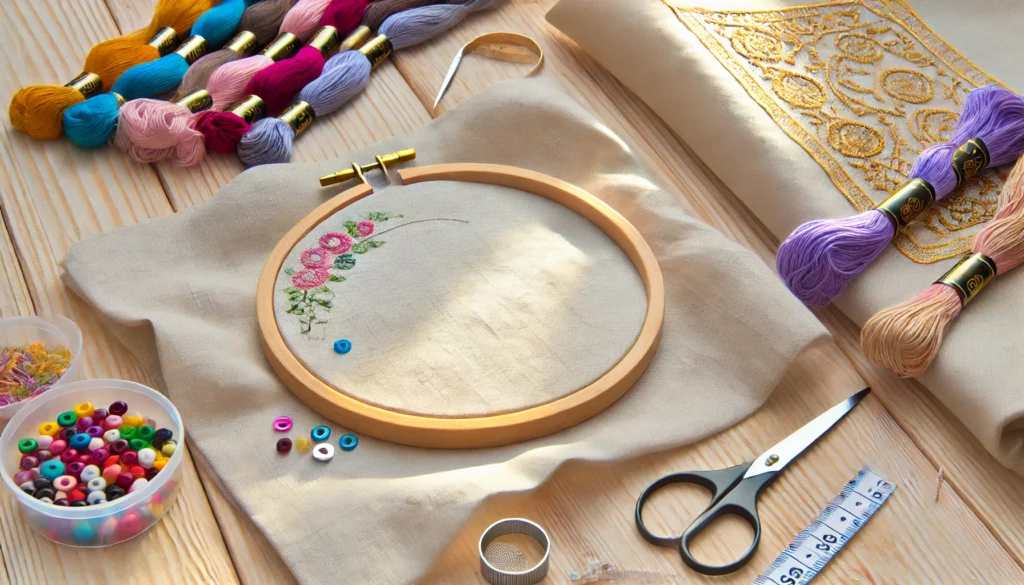
Tools and Materials Required for Aari Work
Before diving into the step-by-step guide, it is essential to have the right tools and materials on hand. Here is a list of essential tools and materials needed for Aari embroidery:
- Aari Needle (Tambour Needle): The primary tool used in Aari work, the Aari needle, is a fine, sharp hook resembling a crochet needle. It is designed to create intricate chain stitches with great precision.
- Wooden Hoop Frame: A wooden or plastic embroidery hoop is used to stretch and secure the fabric tightly, ensuring stability while working on the intricate designs. The frame helps maintain tension, making it easier to work with the needle.
- Embroidery Thread (Silk or Cotton): Aari work typically involves colorful silk or cotton threads. The type of thread used can vary based on the design, fabric, and desired finish.
- Fabric (Blouse Material, Silk, Cotton): Aari embroidery can be done on various fabrics, including silk, cotton, georgette, and net. The fabric choice depends on the garment you wish to embellish and the design’s complexity.
- Beads, Sequins, and Stones: To add more embellishments, beads, sequins, stones, and other decorative materials are used to enhance the beauty of the embroidery.
- Scissors: A pair of sharp scissors is essential for cutting threads and fabric edges neatly.
- Chalk or Fabric Marker: Chalk or a fabric marker is used to outline the design on the fabric before starting the embroidery.
- Thread Cutter: A thread cutter is a handy tool for trimming excess threads while working.
- Thimble: A thimble protects your fingers from needle pricks and provides a better grip on the needle.
- Measuring Tape and Ruler: These tools help ensure accuracy while marking and designing on the fabric.
Step-by-Step Guide to Aari Work on Blouses
Now that you have gathered all the necessary tools and materials, it’s time to begin the Aari embroidery process. Follow these steps to create beautiful Aari work on blouses:
Step 1: Prepare the Fabric
Begin by selecting the fabric for the blouse. Wash and iron the fabric to remove any wrinkles. Stretch the fabric onto the wooden hoop frame, ensuring it is taut and wrinkle-free. Tighten the screw to secure the fabric firmly in place.
Step 2: Draw the Design
Using chalk or a fabric marker, draw the desired design on the fabric. Start with a simple design if you are a beginner, as intricate designs require more skill and patience. Ensure that the design is clear and easy to follow.
Step 3: Thread the Aari Needle
Choose the appropriate color of embroidery thread and thread the Aari needle. Aari needles come with a small hole at the tip for threading. Ensure the thread is securely in place to prevent it from slipping while working.
Step 4: Start the Chain Stitch
Begin stitching by inserting the Aari needle into the fabric from the underside. Pull the needle up through the fabric and create a loop with the thread. Insert the needle again close to the previous stitch and pull the thread to form a chain stitch. Continue this process, following the outline of the design.
Step 5: Add Beads and Sequins
To enhance the design, you can add beads, sequins, and stones. Place a bead or sequin on the needle, and secure it with a small stitch before continuing with the chain stitch. Repeat this process, spacing the beads and sequins evenly as per the design.
Step 6: Complete the Design
Continue stitching and embellishing the design until you have covered the entire pattern. Be patient and ensure each stitch is neat and uniform. Take breaks if needed to avoid straining your eyes and hands.
Step 7: Finish and Secure the Threads
Once the embroidery is complete, finish by tying a knot at the end of the thread on the underside of the fabric. Trim any excess threads with the thread cutter or scissors. Remove the fabric from the hoop frame and gently iron it on the reverse side to flatten the stitches.
Step 8: Final Touches
Inspect the embroidery to ensure no loose threads or uneven stitches. Make any necessary adjustments or additions to perfect the design. Your Aari-embroidered blouse is now ready to wear or gift!
Conclusion
Aari work requires practice and patience, but the results are worth the effort. With the right tools, materials, and step-by-step guidance, even beginners can master the art of Aari embroidery. Start with simple designs and gradually move to more complex patterns as you gain confidence and skill. Aari work not only enhances the beauty of traditional blouses but also adds a personal touch to any outfit.
DIY Terracotta Jewelry: Unleash Your Creativity with These Easy Step-by-Step Images!
Learn how to make terracotta jewelry with our step-by-step guide. Discover the materials needed, tips, and tricks to create beautiful, sustainable pieces at home.
Terracotta jewelry, known for its earthy and rustic charm, is becoming a popular choice among DIY enthusiasts and fashion lovers alike. This handcrafted jewelry, made from natural clay, can be customized in endless designs, making it both unique and sustainable. If you’re looking to create your own terracotta jewelry, this guide will take you through the process step-by-step, complete with images to help you craft stunning pieces right at home.
What You Need to Get Started
Before diving into the steps, gather these essential materials:
- Terracotta clay (available in art supply stores)
- Rolling pin or clay roller
- Cookie cutters or any small mold for shaping
- Sandpaper
- Water and sponge
- Paints (acrylic or fabric paints)
- Paintbrushes
- Jewelry findings (hooks, earring posts, chains, etc.)
- Needle or pin for making holes
- Clear varnish or glaze for finishing
Step-by-Step Process to Make Terracotta Jewelry
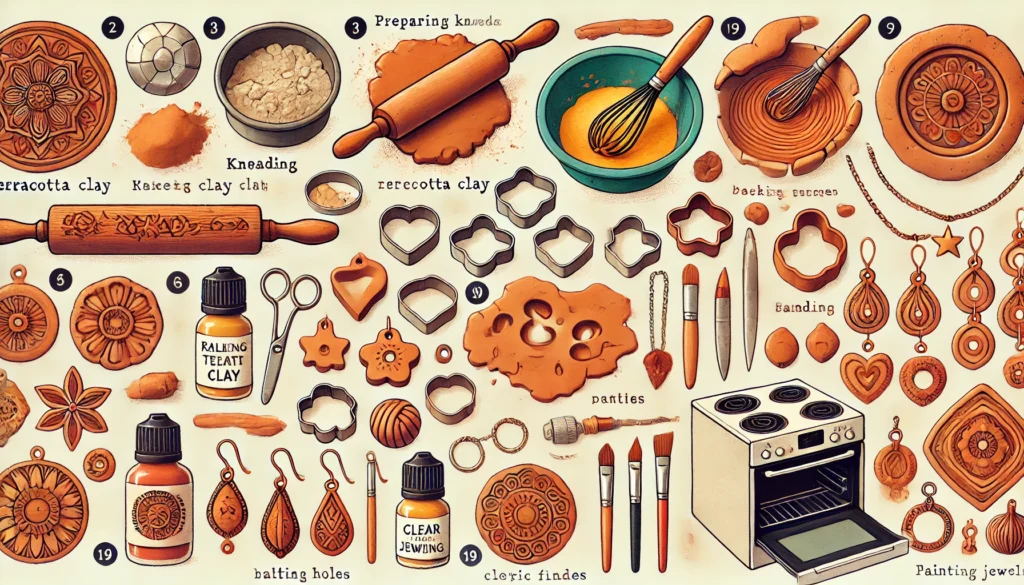
Step 1: Prepare the Clay
To start, take a small amount of terracotta clay and knead it well. Ensure there are no air bubbles, as they can cause cracks during the baking process. The clay should be soft and pliable. If it’s too dry, add a few drops of water and knead again.
Step 2: Roll Out the Clay
Using a rolling pin or clay roller, flatten the clay to your desired thickness—typically around 3 to 5 mm. This thickness ensures that the jewelry pieces are sturdy yet not too heavy to wear.
Step 3: Cut Out Shapes
Use cookie cutters, molds, or a knife to cut out shapes from the rolled-out clay. Popular shapes for terracotta jewelry include circles, squares, leaves, and geometric patterns. If you want to add more intricate designs, use a needle or a carving tool to create patterns on the surface of the clay.
Step 4: Make Holes for Findings
Using a needle or pin, carefully poke holes where you want to attach hooks, chains, or other findings. Ensure the holes are big enough to accommodate your jewelry findings but not too large that they compromise the structure of the clay.
Step 5: Smooth the Edges
Gently smooth the edges of each piece with a damp sponge or your fingers. This will help give a more polished and refined look to the final product. Let the pieces dry for a bit before moving on to the next step.
Step 6: Bake the Clay
Preheat your oven to 220°F (104°C). Place the clay pieces on a baking tray lined with parchment paper and bake for 30-40 minutes. Baking time may vary depending on the size and thickness of your pieces, so keep an eye on them. Once baked, let them cool completely before handling.
Step 7: Sand and Refine
Once the pieces are baked and cooled, use fine-grit sandpaper to smooth out any rough edges or surfaces. This step is crucial for giving your jewelry a professional finish.
Step 8: Paint Your Jewelry
Now comes the fun part—painting! Use acrylic or fabric paints to decorate your jewelry pieces. You can choose traditional designs or contemporary patterns, depending on your style preference. Allow the paint to dry completely.
Step 9: Apply a Varnish
To seal the paint and give the jewelry a shiny finish, apply a layer of clear varnish or glaze. This step also makes the jewelry water-resistant and more durable.
Step 10: Assemble the Jewelry
Attach hooks, chains, and other findings to your jewelry pieces using the holes made earlier. Use pliers to securely attach these findings, ensuring your jewelry is both functional and beautiful.
Step 11: Enjoy Your Handmade Terracotta Jewelry!
Congratulations! You’ve now created your very own terracotta jewelry. Whether it’s a pair of earrings, a necklace, or a bracelet, these handmade pieces are perfect for any occasion and make great gifts too.
Tips for Making Terracotta Jewelry
- Experiment with different shapes, sizes, and colors to create a diverse collection.
- If you’re new to painting, start with simple designs and gradually work your way up to more intricate patterns.
- Always wear a mask when sanding the baked clay to avoid inhaling any dust.
Conclusion
Making terracotta jewelry at home is a fun, creative, and eco-friendly activity that allows you to express your artistic side. With this step-by-step guide and a bit of practice, you’ll be crafting beautiful, unique jewelry pieces in no time!
Discover the unexpected comeback of ancient beadwork and beaded jewelry traditions that are turning heads!
Uncover how ancient beadwork and beaded jewelry traditions are making a vibrant comeback. Learn why these intricate pieces are capturing modern fashion.
Beadwork and beaded jewelry are experiencing a surprising resurgence, with contemporary fashion circles embracing this ancient art form in unexpected ways. Once relegated to traditional attire and cultural events, beadwork is now making bold statements on global runways and modern accessories. This vibrant craft is not just about decoration; it is a reflection of cultural heritage, artistic expression, and sustainable fashion. The revival of beaded jewelry aligns with a broader trend of returning to handcrafted, unique items that tell a story beyond the mass-produced world of fast fashion.
The History and Cultural Significance of Beadwork
Beadwork and beaded jewelry have deep historical roots, tracing back thousands of years across various cultures, from African tribes to Native American communities, and even ancient Egyptian societies. Each bead, whether made from bone, shell, glass, or gemstone, carried meaning and purpose, representing status, spirituality, or cultural identity. Beadwork was not only an artistic endeavor but also a societal marker.
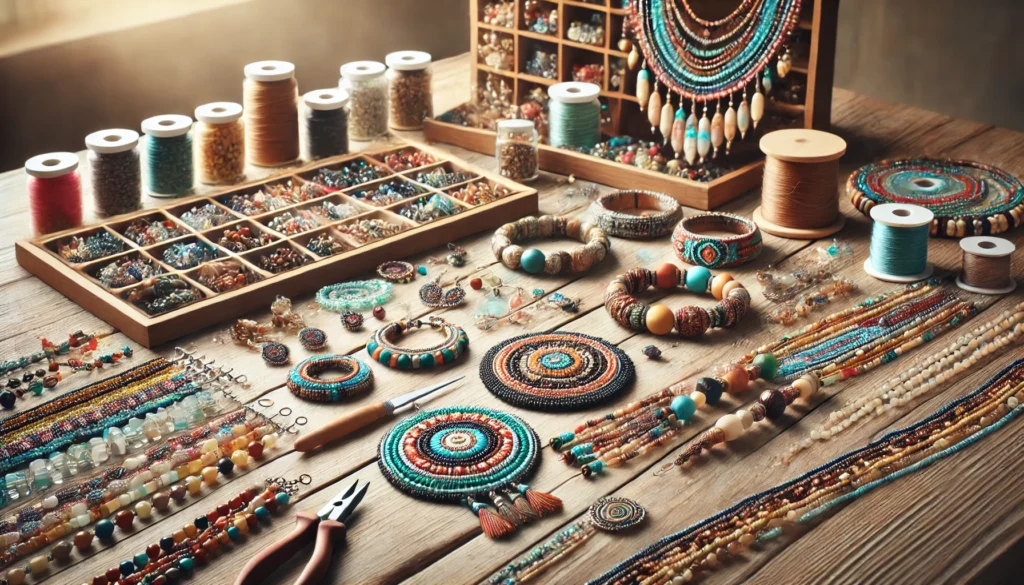
According to historians, beadwork served as a medium of communication and expression, with patterns and colors holding specific meanings. Beadwork expert Carol Wilcox noted that beads have been considered “an essential part of human expression, similar to language or music.” Today, modern artisans are reviving these ancient practices, infusing them with contemporary designs to appeal to today’s fashion enthusiasts.
Beadwork as a Modern Fashion Statement
In recent years, beaded jewelry has evolved beyond its traditional boundaries, finding a place in modern fashion as a statement piece. This transformation has been fueled by a growing appreciation for slow fashion—an approach that values craftsmanship, sustainability, and individuality. Fashion influencers and celebrities have embraced beaded jewelry for its versatility and unique aesthetic, often opting for custom-made pieces that reflect personal style.
The modern resurgence can also be attributed to a desire for more meaningful and ethical fashion choices. Unlike machine-made accessories, each beaded piece requires hours of meticulous handwork, making every piece unique. A recent fashion analyst noted that “the labor-intensive nature of beadwork aligns perfectly with current trends that favor authenticity and artisanal quality over mass-produced uniformity.”
Craftsmanship Meets Innovation: New Trends in Beaded Jewelry
The revival of beadwork is not just about re-creating traditional patterns but also about innovation and new trends. Artisans are experimenting with unconventional materials like recycled glass, sustainable beads, and even 3D-printed beads. The fusion of traditional techniques with modern technology is giving rise to fresh, innovative designs that cater to a broader market.
For example, mixed-media beadwork that combines metal, fabric, and traditional beads is becoming increasingly popular. This trend adds a contemporary twist to the classic beadwork, making it more appealing to younger consumers. Fashion expert Janet Wong observed that “by blending the old with the new, artisans are redefining what beadwork can be, ensuring it stays relevant in an ever-changing fashion landscape.”
The Future of Beadwork in the Global Market
Industry experts believe that beadwork is on track to secure a permanent place in the global market, particularly as consumers become more conscious of sustainability and the stories behind their purchases. The craft’s adaptability to modern tastes, coupled with its rich cultural heritage, gives it a unique edge.
Moreover, with the rise of online marketplaces like Etsy and Amazon Handmade, artisans from around the world now have a platform to showcase their unique creations to a global audience. As a result, there has been an increase in demand for authentic, handcrafted beaded jewelry, which not only supports local artisans but also promotes cultural heritage.
Jewelry designer Alicia Miller stated, “The value of beadwork lies not just in its beauty, but in its ability to connect the wearer to a rich tapestry of history and culture.” With the right balance of innovation and tradition, the future of beadwork appears bright and promising.
A Craft that Transcends Time
The resurgence of beadwork and beaded jewelry is more than just a fashion trend—it is a movement towards embracing heritage, sustainability, and craftsmanship in a modern context. As artisans continue to innovate while preserving ancient techniques, beadwork is set to remain a vibrant and cherished part of the global fashion scene.
Why handmade accessories are the next big thing in fashion – and you won’t believe the impact!
Explore how handmade accessories are transforming fashion with unique designs and sustainable practices. Learn why they are the ultimate style statement.
Handmade accessories are taking the fashion world by storm, offering a fresh alternative to mass-produced items that dominate the market. These one-of-a-kind pieces—ranging from hairpins and headbands to anklets and brooches—provide a personalized touch that is becoming increasingly rare in today’s fashion landscape. As more consumers seek unique ways to express themselves, the demand for handcrafted accessories continues to grow, underscoring a broader movement toward individuality, quality, and sustainable fashion choices.
The Rise of Handmade Accessories in Modern Fashion
Handmade accessories have become a symbol of authenticity and originality in a fashion market flooded with uniformity. Unlike factory-made items, these accessories are crafted with meticulous attention to detail and infused with the artist’s creative spirit. Each piece tells a story, making it more than just an accessory but a wearable piece of art. Fashion historian Linda Larson explained that “handmade accessories connect the wearer with the creator’s vision, offering a sense of connection that mass-produced items simply cannot replicate.”
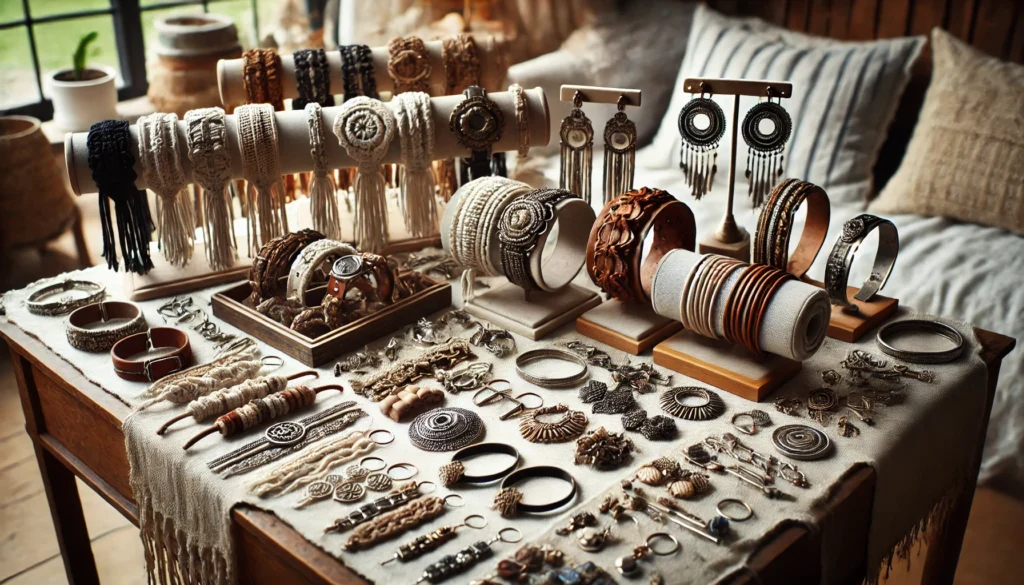
The rise in popularity of handmade accessories also reflects a growing rejection of fast fashion’s ethical and environmental implications. With consumers becoming more aware of the impact of their choices, there is a clear shift towards slow fashion, which values craftsmanship, sustainability, and ethical production. Artisanal brands and independent designers are leading this change, creating accessories that are both stylish and sustainable.
Why Consumers Are Flocking to Handmade Accessories
The appeal of handmade accessories lies in their uniqueness and the ability to customize them according to personal preferences. Many artisans offer bespoke services, allowing customers to choose specific colors, materials, and designs, resulting in a product that perfectly matches their style. This level of personalization is rarely found in mass-produced goods and is a key reason why handmade accessories are becoming more popular.
Additionally, handmade accessories often feature high-quality, durable materials. Unlike their cheaper, mass-produced counterparts, which are prone to wear and tear, handmade items are built to last. Many artisans use sustainable and ethically sourced materials, such as recycled metals, natural fabrics, or even upcycled components. This commitment to quality and sustainability adds to the allure of handmade accessories.
Craftsmanship and Artistry: The Essence of Handmade Accessories
At the heart of handmade accessories is the dedication and skill of the artisans who create them. Each piece requires hours, sometimes even days, of labor-intensive work. The artistry involved is what sets handmade accessories apart from their mass-produced counterparts. Jewelry designer Samira Thompson noted that “the time and skill invested in handmade accessories give them a soul—a story that the wearer carries with them.”
The market for handmade accessories includes a wide range of items, such as macramé earrings, crochet hairbands, leather cuffs, and metal brooches. Each accessory type reflects different craft techniques and materials, showcasing the rich diversity of artisanal work. As a result, handmade accessories appeal to a broad spectrum of consumers, from those who prefer minimalist styles to those seeking bold, statement pieces.
The Market Potential for Handmade Accessories
Experts believe that the market for handmade accessories will continue to grow as consumers increasingly prioritize sustainability, quality, and individuality. The rise of e-commerce platforms and social media has also provided artisans with greater visibility and access to global markets. Sites like Etsy, Instagram, and Pinterest have become crucial tools for artisans to showcase their work, connect with customers, and build their brands.
According to fashion marketing strategist Julia Reed, “the appeal of handmade accessories is more than just their aesthetic value. It’s about owning something that’s truly yours—an item that no one else has. This unique selling point is what makes handmade accessories a promising niche in the fashion industry.”
The Future of Fashion is Handmade
The trend toward handmade accessories signals a shift in consumer values, from quantity to quality and from conformity to individuality. As more people seek meaningful, sustainable, and unique fashion choices, handmade accessories are poised to become a staple in modern wardrobes. This growing demand will likely lead to more innovation and diversity in designs, ensuring that the future of fashion remains vibrant, sustainable, and deeply personal.
Why textile and fabric-based jewelry is the hottest new trend in sustainable fashion!
Discover how textile and fabric-based jewelry is revolutionizing sustainable fashion. Learn how these unique pieces are crafted and their growing appeal.
Textile and fabric-based jewelry is redefining sustainable fashion, bringing creativity, innovation, and eco-consciousness together in an unexpected and captivating way. Moving beyond traditional metal and gemstone options, artisans are turning to soft materials like cotton, jute, felt, and recycled fabrics to create stunning, lightweight jewelry that is both stylish and sustainable. With a growing emphasis on environmental responsibility in the fashion industry, fabric-based jewelry is emerging as a unique and ethical alternative, appealing to a diverse audience seeking distinctive fashion statements.
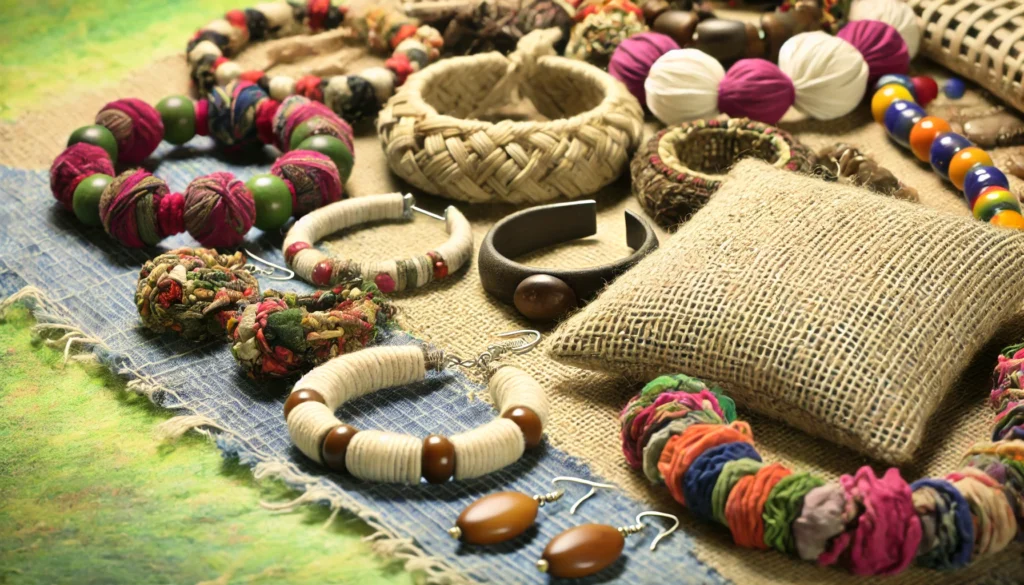
The Emergence of Textile and Fabric-Based Jewelry
The concept of textile and fabric-based jewelry is not entirely new; it draws inspiration from age-old practices where communities around the world used natural fibers and textiles to adorn themselves. However, in recent years, this type of jewelry has gained significant traction in mainstream fashion circles, thanks to the push for sustainability and ethical fashion. According to fashion historian Anita Patel, “fabric-based jewelry represents a shift towards valuing materials that are renewable, biodegradable, and have a lower carbon footprint.”
The versatility of textile jewelry is another reason for its rising popularity. From statement necklaces made of braided cotton to intricately woven jute earrings and patchwork fabric cuffs, these pieces offer endless design possibilities. The use of vibrant colors, unique textures, and innovative weaving techniques allows designers to craft accessories that are not only visually appealing but also rich in cultural significance.
How Textile and Fabric-Based Jewelry is Crafted
Creating fabric-based jewelry involves a blend of traditional craftsmanship and modern design techniques. Many artisans start by selecting high-quality, sustainable fabrics—such as organic cotton, hemp, silk, or even repurposed materials like denim or sari fabrics. These textiles are then cut, shaped, and treated to create various jewelry elements. Techniques like braiding, knotting, stitching, and embroidery are commonly used to give the pieces form and structure.
Textile jewelry often incorporates other sustainable materials such as wood, shells, or seeds to add depth and dimension. Designers might also use natural dyes and eco-friendly adhesives to ensure the final product is entirely sustainable. Jewelry designer and environmental advocate Sasha Morgan pointed out that “every step in the creation process of fabric-based jewelry, from material selection to finishing touches, is an opportunity to make a more sustainable choice.”
The Growing Appeal of Sustainable Jewelry
The demand for textile and fabric-based jewelry is driven by a growing desire for sustainable fashion. Today’s consumers are increasingly concerned about the environmental impact of their purchases and are opting for products that align with their values. Fabric-based jewelry fits perfectly within this mindset, offering a stylish yet conscious alternative to traditional jewelry.
Another key appeal of textile jewelry is its comfort and lightweight nature. Unlike heavy metal pieces, fabric-based jewelry can be worn for extended periods without discomfort. This quality makes it particularly popular for summer wear and casual styling, where comfort and style go hand-in-hand. Moreover, the customizable nature of textile jewelry means that pieces can be tailored to suit specific tastes or complement particular outfits, adding a unique touch to any wardrobe.
The Future of Fabric-Based Jewelry
Fashion industry experts believe that fabric-based jewelry has significant growth potential, especially as more consumers and brands embrace sustainable practices. The trend is also gaining momentum thanks to increased visibility on social media and e-commerce platforms, where independent artisans and small-scale designers showcase their creations to a global audience.
Ethical fashion consultant Monica Vance noted that “textile jewelry represents a convergence of art, culture, and sustainability—three elements that modern consumers find increasingly attractive.” She also emphasized that as fashion continues to evolve toward more sustainable practices, fabric-based jewelry will likely become a staple in the accessory market.
A New Era of Fashion Accessories
Textile and fabric-based jewelry is more than just a trend; it is a reflection of the changing values in fashion. As more people seek accessories that are not only beautiful but also ethical and sustainable, the appeal of fabric-based jewelry will continue to grow. With a focus on craftsmanship, innovation, and environmental responsibility, this unique form of jewelry is set to make a lasting impact on the fashion world.
How embroidery and thread art are redefining jewelry – the stunning transformation you need to see!
Explore how embroidery and thread art are being reimagined in jewelry design, combining tradition with innovation. Discover this evolving trend now.
Embroidery and thread art are experiencing a renaissance in the world of jewelry design, where traditional needlework techniques are being reimagined to create intricate and elegant accessories. From embroidered pendants to thread-wrapped earrings and intricate Aari-work bracelets, these handmade pieces blend the timeless charm of needle and thread with contemporary fashion sensibilities. As fashion trends lean towards authenticity, sustainability, and personalization, embroidery and thread art jewelry are becoming a favorite among those seeking unique and meaningful adornments.
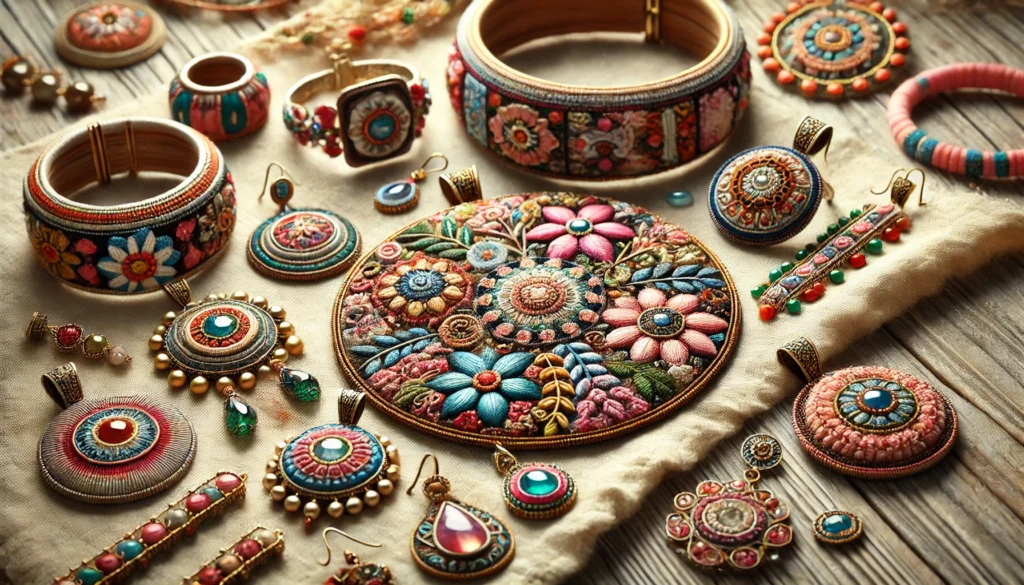
The Resurgence of Embroidery and Thread Art in Jewelry
Historically, embroidery has been a part of textile embellishment for centuries, with different styles and techniques emerging across various cultures. However, incorporating these intricate designs into jewelry is a more recent phenomenon that has caught the eye of modern fashion designers and enthusiasts. The shift is driven by a growing appreciation for handcraftsmanship, sustainable practices, and the desire for accessories that tell a story. Art historian Megan Searle emphasized that “embroidery and thread art are more than just decorative crafts; they are a means of storytelling, reflecting cultural heritage and personal narratives.”
As consumers move away from mass-produced items, the demand for handmade, embroidered jewelry has surged. These pieces often feature a blend of traditional techniques such as zardozi, Kantha, or Aari work, with modern designs that cater to contemporary tastes. The result is a range of unique jewelry that is both rich in heritage and aligned with current fashion trends.
How Embroidery and Thread Art Jewelry is Made
Creating embroidery and thread art jewelry involves a detailed and labor-intensive process. Artisans use various stitches, from the simple backstitch to the more intricate bullion knot, to form patterns and motifs on fabric bases. These embroidered pieces are then incorporated into jewelry settings such as metal frames for pendants or earrings. Thread-wrapped bangles and rings are another popular style, where colorful threads are meticulously wrapped around a base to create vibrant, textured jewelry.
A unique aspect of embroidered jewelry is its versatility. Designers can use different materials—such as silk, cotton, or metallic threads—and incorporate beads, sequins, and gemstones to add depth and dimension. Fashion designer Rachel Tan remarked that “the beauty of embroidery lies in its adaptability; it can be as minimalist or as extravagant as one desires.”
The Growing Popularity of Embroidered Jewelry
The appeal of embroidery and thread art jewelry lies in its ability to blend traditional craftsmanship with modern design sensibilities. Many consumers are drawn to these pieces because they represent a fusion of history and innovation. Each piece of embroidered jewelry is one-of-a-kind, reflecting the artist’s skill and creativity. This uniqueness is particularly appealing in a market saturated with generic accessories.
Moreover, embroidered jewelry often aligns with the principles of slow fashion. It takes time, skill, and patience to produce each piece, which contrasts sharply with the mass production typical of the fast fashion industry. Consumers who value sustainability and ethical production practices are increasingly choosing embroidered jewelry for this reason. Jewelry market analyst Karen Zhao noted that “handcrafted embroidery in jewelry is a powerful statement against the disposable nature of modern fashion.”
The Future of Embroidery in Jewelry Design
Experts believe that embroidery and thread art will continue to thrive in jewelry design, especially as the trend toward personalized and meaningful fashion grows stronger. The craft’s adaptability allows it to evolve with changing fashion trends, ensuring its relevance in the future. Additionally, as more designers and consumers recognize the value of handcrafted, sustainable accessories, embroidered jewelry is poised to occupy a significant space in the fashion market.
Fashion trend analyst Isabella King highlighted that “embroidered jewelry is not just a trend but a testament to the timeless elegance of needlework. It bridges the gap between the past and the present, making it a versatile choice for fashion-forward consumers.”
A Timeless Craft with a Modern Twist
Embroidery and thread art have successfully transcended their traditional roots to become a significant trend in jewelry design. By combining age-old techniques with contemporary styles, artisans are crafting pieces that are as unique as they are meaningful. As the fashion industry continues to embrace sustainability and authenticity, embroidery and thread art jewelry will likely remain a cherished choice for those who appreciate the beauty of handmade craftsmanship.
The unexpected rise of polymer clay and resin jewelry – and why everyone is obsessed!
Discover how polymer clay and resin jewelry are transforming handmade accessories with vibrant designs and endless customization options.
Polymer clay and resin jewelry are quickly becoming popular in the world of handmade accessories, captivating fashion enthusiasts with their vibrant colors, intricate designs, and limitless possibilities for customization. Unlike traditional materials like metal or stone, polymer clay and resin offer artisans a flexible medium to craft unique and eye-catching jewelry pieces, ranging from whimsical earrings to bold statement necklaces. This modern revolution in jewelry design is redefining what handmade accessories can be, attracting both designers and consumers who value creativity and individuality.

The Rise of Polymer Clay and Resin Jewelry
The popularity of polymer clay and resin jewelry has surged in recent years, driven by social media platforms like Instagram and TikTok, where artisans share their creative processes and showcase their colorful designs. Unlike conventional jewelry, polymer clay and resin pieces are lightweight, versatile, and highly customizable. This flexibility allows artists to experiment with endless shapes, patterns, and color combinations, resulting in jewelry that is as unique as the wearer.
Jewelry designer Olivia Green explained that “polymer clay and resin offer a freedom that traditional jewelry materials don’t. There are no limits to the shapes, colors, or textures you can create, which makes it an exciting medium for artists.” This sense of freedom and creativity is a significant draw for both designers and customers looking for something different from the norm.
How Polymer Clay and Resin Jewelry is Made
Creating jewelry from polymer clay and resin involves a meticulous process that requires both artistic skill and technical knowledge. For polymer clay jewelry, artisans start by conditioning the clay to achieve the desired consistency and color blend. The clay is then molded into various shapes, such as geometric forms, floral patterns, or even abstract designs. Once shaped, the clay pieces are baked in an oven to harden them, making them durable yet lightweight.
Resin jewelry, on the other hand, involves mixing liquid resin with hardener and adding pigments, glitter, or other decorative elements. The resin mixture is then poured into molds and left to cure for several hours or even days, depending on the type of resin used. The result is a glossy, durable piece of jewelry with a glass-like finish. Combining polymer clay with resin is another popular technique that adds an extra layer of depth and shine to the jewelry, creating pieces that are visually stunning and unique.
The Growing Appeal of Modern Handmade Jewelry
One of the key reasons for the growing appeal of polymer clay and resin jewelry is its accessibility and affordability. Unlike precious metals and gemstones, polymer clay and resin are relatively inexpensive materials, making this type of jewelry more affordable for both creators and consumers. This affordability opens up opportunities for artisans to explore their creativity without the financial risks associated with more traditional jewelry-making materials.
Another factor contributing to the popularity of polymer clay and resin jewelry is its eco-friendly aspect. Many artisans use non-toxic, low-waste materials and adopt sustainable practices in their crafting processes. For instance, some use silicone molds that can be reused hundreds of times, reducing waste. Fashion influencer Mia Santos commented that “the eco-friendly aspect of polymer clay and resin jewelry is a big selling point for consumers who want stylish accessories without compromising their environmental values.”
The Future of Polymer Clay and Resin Jewelry
Experts believe that the future of polymer clay and resin jewelry is bright, particularly as the demand for unique, customizable, and affordable accessories continues to grow. With advancements in polymer and resin materials, the possibilities for creating innovative and sustainable jewelry designs are expanding. Additionally, the rise of online marketplaces and social media platforms has made it easier for independent designers to reach a global audience, further fueling the trend.
Artisanal jewelry consultant Nathan Kim noted that “polymer clay and resin jewelry are here to stay. The combination of artistic freedom, affordability, and sustainability makes it a perfect choice for the modern consumer who wants something different.” He added that as more people discover the versatility of these materials, the market for polymer clay and resin jewelry is likely to expand even further.
A New Age for Handmade Jewelry
Polymer clay and resin jewelry represent a new age in handmade accessories, one where creativity knows no bounds. As more artisans and consumers embrace these versatile materials, the jewelry world is witnessing a shift towards more personalized, sustainable, and affordable options. This modern revolution in jewelry design is a testament to the evolving tastes of fashion-conscious individuals who seek to express themselves through unique and meaningful accessories.
